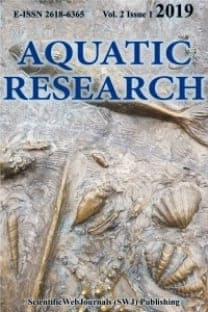EFFECT OF SAVORY EXTRACT SUPPLEMENTATION ON SOME PRODUCTIVE TRAITS AND ECONOMIC EFFICIENCY OF COMMON CARP (Cyprinus carpio L.)
___
Atanasov, V., Staykov, Y., Mitev J. (1999). Biochemical and biological characteristics of Tilapia fingerlings reared at different stock densities. Bulgarian Journal of Agricultural Science, 5, 655-658.Best, P. (2002). Tracking consumer desires: towards total traceability of feed and food. Feed International, 23(2), 4-8.
Charles, D.J. (2012). Savory. In: Antioxidant Properties of Spices, Herbs and Other Sources. Springer, New York, NY USA, 531-536.
Citarasu, T., Venket, R.K., Sekar, J.R., Babu, M., Marian, M.P. (2003). Influence of the antibacterial herbs, Solanum trilobatum, Andrographis paniculata and Psoralea corylifolia on the survival, growth and bacterial load of Penaeus monodon post larvae. Aquaculture International, 11, 583-595.
Costa-Pierce, B.A. (2010).Sustainable Ecological Aquaculture Systems: The Need for a New Social Contract for Aquaculture Development Source. Marine Technology Society Journal, 44(3), 88-112.
Culjak, V., Bogut, G., Has-Schon, E., Milakovic, Z., Canecki, K. (2006). Effect of Bio-Mos on performance and health of juvenile carp. In: Nutrition and biotechnology in the feed and food industries: Alltech’s 22nd annual symposium, Lexington, KY, US.
El-Dakar, A.Y., Shalaby, S.M., Saoud, I.P. (2007). Assessing the use of a dietary probiotic/prebiotic as an enhancer of spinefoot rabbitfish Siganus rivulatus survival and growth. Aquaculture Nutrition, 13(6), 407-412.
Gabor, E., Şara, A., Barbu, A. (2010). The effects of some Phyto-additives on growt, health and meat quality on different species of fish. Animal Sciences and Biotechnologies, 43(1), 61-65.
Gabor, E., Şara, A., Molnar, F., Benţea, M. (2011). The influence of some phytoadditives on growth performances and meat quality in rainbow trout (Oncorhynchus mykiss). Animal Science and Biotechnologies, 44(2), 12-18.
Galeotti, M. (1998). Some aspects of the application of immunostimulants and a critical review of methods for their evaluation. Journal of Applied Ichthyology, 14(3- 4), 189–199.
Jayaprakash, V., Euphrasia, J. (1996). Growth performance of Labeo rohita (Han.) to Livol (IHF-1000), a herbal product. Proceedings of the National Academy of Sciences, B63, 1–10.
Li, P., Gatlin, D.M. (2004). Dietary brewer's yeast and the prebiotic Grobiotic (TM) AE influence growth performance, immune responses and resistance of hybrid striped bass (Morone chrysops x M. saxatilis) to Streptococcus iniae infection. Aquaculture, 231, 445-456.
Mousavi, E., Mohammadiazarm, H., Mousavi, S.M., Ghatrami, E.R. (2016). Effects of inulin, savory and onion powders in diet of juveniles carp Cyprinus carpio (Linnaeus 1758) on gut micro flora, immune response and blood biochemical parameters. Turkish Journal of Fisheries and Aquatic Sciences, 16, 831-838.
Polat, A., Beklevik, G. (1999). The importance of betaine and some attractive substances as fish feed additives. In: Feed Manufacturing in the Mediterranean Region. Recent Advances in Research and Technology, 217- 220.
Raa, J. (1996). The use of immunostimulatory substances in fish and shellfish farming. Reviews in Fish Biology and Fisheries, 4(3), 229-288.
Staykov, Y, Spring, P., Denev, S.А. (2005). Influence of dietary Bio-Mos on growth, survival and immune status of rainbow trout (Salmo gairdneri irideus G.) and common carp (Cyprinus carpio L.). In: Nutritional Biotechnology in the Feed and Food Industries. (Eds. T.P. Lyons, and K. Jackues). Nottingham University Press, Nottingham, UK. 333-343.
Stratev, D., Zhelyazkov, G., Noundou, X.S., Krause, R.W.M. (2018). Beneficial effects of medicinal plants in fish diseases. Aquaculture International, 26, 289-308.
Wedemeyer, G.A. (1997). Effects of rearing conditions on the health and physiological quality of fish in intensive culture. Fish Stress and Health in Aquaculture, 35-73.
Zhou, X., Li, L. (2004). The effect of Bio-Mos on intestinal microflora and immune function of juvenile Jian carp (Cyprinus carpio). In: Nutritional Biotechnology in the Feed and Food Industries, Proceedings of Alltech’s 20th Annual Symposium (Suppl.1: Abstracts of posters presented). Lexington, KY, May 24-26, p. 109.
- ISSN: 2618-6365
- Yayın Aralığı: 4
- Başlangıç: 2018
- Yayıncı: Nuray ERKAN ÖZDEN
Stefka STOYANOVA, Georgi Ivanov ZHELYAZKOV, Katya VELİCHKOVA, Ivaylo SİRAKOV, Yordan STAYKOV
Simon Ihie IKAPE, Shola Gabriel SOLOMON
Nur Efah ARSİN, Abentin ESTİM, Saleem MUSTAFA
GÜNEYDOĞU KARADENİZ RİZE SARAYKÖY PLAJINDA PLASTİK KİRLİLİĞİ
